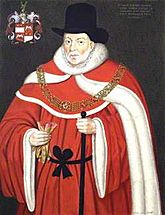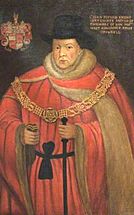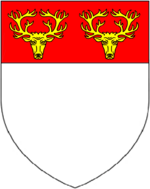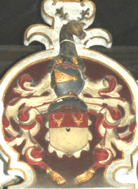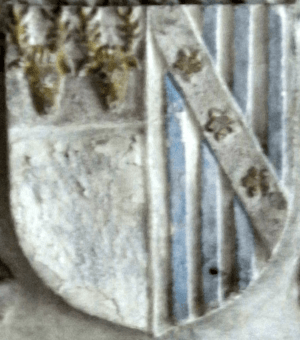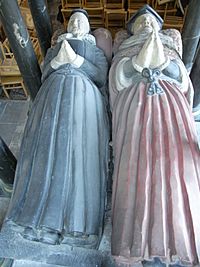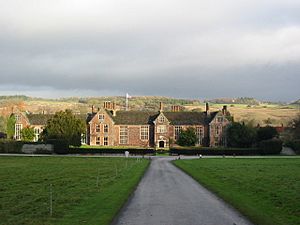John Popham (judge) facts for kids
Quick facts for kids
Sir John Popham
|
|
|---|---|

Sir John Popham (1531–1607), Lord Chief Justice. 1602 portrait by unknown artist, collection of Harvard Law School
|
|
| Born | 1531 Huntworth, North Petherton, Somerset
|
| Died | 10 October 1607 (aged 75–76) |
| Occupation | Speaker of the House of Commons, Attorney General, Lord Chief Justice |
| Spouse(s) | Amy Adams (alias Games) |
| Parent(s) | Alexander Popham, Jane Stradling |
| Signature | |
 |
|
Sir John Popham (1531 – 10 June 1607) was an important English lawyer and judge. He held several high-ranking positions during the reigns of Queen Elizabeth I and King James I. These included being the Speaker of the House of Commons, the Attorney General, and the Lord Chief Justice of England. He was known for his strict approach to law and order.
Contents
Early Life and Family
John Popham was born in 1531 in a place called Huntworth in Somerset, England. He was the second son of Alexander Popham, who was a Member of Parliament (MP) for Bridgwater. His mother was Jane Stradling, whose family lived in St Donat's Castle in Wales.
The Popham family had lived in Huntworth since the 1200s. Sir John Popham had nephews who also became famous. One was George Popham, who helped start the Popham Colony in America. Sir John Popham was one of the main people who helped pay for this colony.
Education and Early Career
John Popham studied at Balliol College, Oxford, where he learned about classical subjects and religion. After that, he went to the Middle Temple to study law. This was a famous place for training lawyers in London.
He became a Member of Parliament (MP) for Lyme Regis in 1558 and later for Bristol. He also worked as a Justice of the Peace in Somerset, helping to keep order and enforce laws. He held important legal roles in the towns of Bridgwater and Bristol.
Rise to Power
In 1578, John Popham became a senior lawyer called a "serjeant-at-law." The next year, he was appointed Solicitor-General. This meant he was a top legal advisor to the Crown.
In 1581, he was chosen to be the Speaker of the House of Commons. This is a very important role, as the Speaker manages debates and keeps order in Parliament. Later that same year, he became the Attorney-General, which is the chief legal officer of the Crown.
In 1592, he reached the highest legal position: Chief Justice of the Queen's Bench. He kept this job until he passed away.
Important Contributions
Sir John Popham played a big part in keeping England stable during a time of change. He is also seen as one of the early supporters of the British Empire.
He helped fund and organize the Popham Colony in Maine, America, which started in 1607. Before this, he hosted two Native American tribesmen from the Wabanaki Confederacy who had been brought to England in 1605.
Popham became a very rich man. He owned many large properties, including Publow in Somerset and Littlecote House in Wiltshire. He also helped establish Blundell's School in Tiverton, Devon. This was a free grammar school, meaning it provided education without charge. The school opened in 1604 and is still open today.
Famous Cases and Challenges
Sir John Popham presided over several very famous trials. In 1595, he was the judge in the trial of the Jesuit priest Robert Southwell. He also oversaw the trials of Sir Walter Raleigh in 1603 and the people involved in the Gunpowder Plot, including Guy Fawkes, in 1606. He was also part of the trial of Mary, Queen of Scots in 1587, which led to her execution.
At one point, he was held captive by Robert Devereux, the Earl of Essex. Sir John Popham remained calm, saying that at his age, death would "cut off only a few years." Luckily, he was rescued by Sir Ferdinando Gorges.
He was known for being very strict with people who committed crimes, especially thieves. He also strongly enforced the laws of the time.
Family Life
John Popham married Amy Adams. She was the daughter and heir of Hugh Adams from Castleton in Glamorgan, Wales. Through this marriage, Popham gained ownership of Castleton, which he later sold to his relative, Sir Thomas Stradling.
Sir John and Amy had one son and six daughters:
- Sir Francis Popham (around 1573 – 1644) was their only son and inherited his father's estates. He also became an MP. His son, Colonel Alexander Popham (1605–1669), fought for Parliament during the English Civil War.
- Penelope Popham
- Elinor Popham
- Elizabeth Popham (died 1637), who married Sir Richard Champernowne.
- Mary Popham
- Amy Popham
Homes and Estates
Wellington House, Somerset
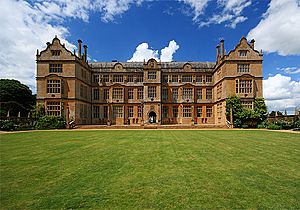
Sir John Popham built a large and impressive home called Wellington House in Wellington, Somerset. It was almost as big as Montacute House, another famous mansion built around the same time.
Sadly, Wellington House was destroyed during the English Civil War (1642–1651). It was taken over by Parliamentarian forces and defended against Royalist attacks. During the fighting, the house was so badly damaged that it could not be repaired.
Littlecote House, Berkshire
Popham also became the owner of Littlecote House in Berkshire (now in Wiltshire) after the death of William Darrell in 1589. There's a story that Popham got Littlecote as a favor for helping William Darrell avoid a murder charge, but historians say this story is not entirely accurate.
Sir John Popham made the house bigger by adding a new south wing made of red brick. This part of the house still stands today, and you can see his family's symbols carved above the front door.
After Wellington House was destroyed, Littlecote became the main home for his family for many years.
Death and Burial
Sir John Popham passed away on 10 June 1607 in Wellington, Somerset. He was buried in the Church of St John the Baptist, Wellington. A large monument was built there to remember him and his family.
Monument in Wellington Church
Inside the Church of St John the Baptist in Wellington, there is a tall monument, about 18 feet high, dedicated to Sir John Popham and his family.
On the monument, there are statues of Sir John Popham and his wife. Sir John is shown wearing his judge's robes and a small black cap. Around them are smaller figures. At the ends of the monument, there are two couples kneeling, likely representing his son and daughter-in-law, and his parents.
On one side, there are nine kneeling female figures, thought to be his six daughters and three ladies-in-waiting. On the other side, there are figures believed to be his son Sir Francis Popham's five sons and eight daughters.
A stone tablet on the monument says: Sr John Popham Knighte and Lord Chief Justice of England and of the Honorable Privie Councell to Queene Elizabeth and after to King James, aged 76, died the 10th of June, 1607 and is here interred.
Images for kids


